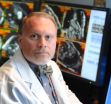(Press-News.org) This press release is available in Spanish.
Ensuring the monarch butterfly's survival by saving its milkweed habitat could result from U.S. Department of Agriculture (USDA) studies initially intended to improve detection of boll weevils with pheromone traps.
Charles Suh and his colleagues at the Agricultural Research Service (ARS) Areawide Pest Management Research Unit in College Station, Texas, have found a pheromone formula that is attractive to a major milkweed pest, the milkweed stem weevil.
The discovery stems from research originally designed to help improve pheromone lures used in Texas to monitor the boll weevil, a major pest of cotton. The lures haven't always been effective, so the researchers worked with the pheromone manufacturer to improve the pheromone lure used in the traps.
The researchers set up traps along roads in Texas to compare the standard and experimental lures for attracting boll weevils. They checked the traps once a week from mid-May to mid-June, replacing the lures every other week.
They soon found that the experimental lures were attracting a type of weevil distinctly different from boll weevils. The weevils were identified as milkweed stem weevils, Rhyssomatus lineaticollis. The researchers initially discounted the number of milkweed stem weevils found in the traps, but it soon became obvious that more milkweed stem weevils were being captured than boll weevils. Overall, four times more milkweed weevils were captured in traps with the experimental lures than with standard lures.
Monarch butterflies are often admired for their eye-catching wings and transcontinental migrations. Conservationists concerned about the potential loss of milkweed habitat have recommended planting milkweed in yards and gardens. Adult monarch butterflies feed on the nectar of various wild flowers when they migrate from the Midwestern United States to the mountains of central Mexico. But their larvae feed on milkweed, making the plant a necessity for the butterfly's lifecycle.
The discovery could be used to develop a trap-based system for detecting milkweed weevil populations, monitoring their movements, and helping conserve rare types of milkweed.
###
Read more about this research in the October 2012 issue of Agricultural Research magazine.
http://www.ars.usda.gov/is/AR/archive/oct12/weevils1012.htm
ARS is the USDA's principal intramural scientific research agency.
USDA is an equal opportunity provider and employer. To file a complaint of discrimination, write: USDA, Office of the Assistant Secretary for Civil Rights, Office of Adjudication, 1400 Independence Ave., SW, Washington, DC 20250-9410 or call (866) 632-9992 (Toll-free Customer Service), (800) 877-8339 (Local or Federal relay), (866) 377-8642 (Relay voice users).
Trapping weevils and saving monarchs
2012-10-01
ELSE PRESS RELEASES FROM THIS DATE:
Macrophage accumulation of triglycerides yields insights into atherosclerosis
2012-10-01
Bethesda, MD—A research report appearing in the Journal of Leukocyte Biology helps explain how specific immune cells, called macrophages, accumulate triglycerides to support their function. Because a characteristic finding in atherosclerosis is the accumulation of fat in macrophages in the arterial wall, understanding how macrophages accumulate triglycerides may lead to new approaches toward slowing or stopping the development of atherosclerosis.
"Activation of macrophages leads to the accumulation of triglycerides in macrophages by multiple pathways that may have beneficial ...
Genetic activity in the entire genome of multicellular fungi analysed at a stroke
2012-10-01
With a combination of microscopic laser scissors and modern sequencing methods, biologists at the Ruhr-Universität have analyzed the activity of genes in the entire genome of certain fungi in one fell swoop. Especially with organisms in the millimetre size range, it is a particular challenge because little cell material is available. The scientists of the RUB Department of General and Molecular Botany took advantage of the method to investigate the development of small multicellular fungi. The results are reported in the journal BMC Genomics.
Gene activity differs from ...
How sexual power can be disempowering
2012-10-01
Gender roles and norms play a key role in sexual behavior between men and women. It is often assumed that men should dominate women sexually. This assumption may lead to loss of both power and the ability to control sexual behavior among women and men, as well as lead to increased sexual risk-taking, such as not using a female condom. The new study, by Dr. Lisa Rosenthal from Yale University in the US, and her colleagues, is published online in Springer's journal Sex Roles.
Social dominance orientation is a measure of people's level of support for social power inequalities ...
Study questions association between common heartburn drugs and risk of pneumonia
2012-10-01
Previous studies that have associated the use of proton pump inhibitors (PPI) – which include popular anti-heartburn medications like Prilosec and Nexium – with an increased incidence of pneumonia may not have found a true cause-and-effect relationship. A study that has been released online by the Journal of General Internal Medicine outlines a strategy for determining when the results of such observational studies may have been distorted by unmeasured factors and then finds that may be the case with the association between PPIs and pneumonia risk.
"Our study is the ...
PET predicts early response to treatment for head and neck cancer patients
2012-10-01
Reston, Va. (October 1, 2012) – Determining the optimal treatment course and predicting outcomes may get easier in the future for patients with head and neck sqaumous cell carcinomas (HNSCCs) with the use of an investigational imaging agent. Research published in the October issue of The Journal of Nuclear Medicine shows that positron emission tomography (PET) imaging with 3'-deoxy-3'F-18-fluorothymidine (18-F-FLT) during treatment and early follow-up has the potential to predict therapeutic responses and identify patients needing close follow-up to detect persistent or ...
Radiology is front and center in health care reform
2012-10-01
AUGUSTA, Ga. – While it's leveling off, a decade of increased use of sophisticated, expensive, imaging studies has put radiologists and their specialty front and center in health care reform, says the chair of an academic radiology department.
That seemingly dubious distinction gives radiologists the chance to take a leadership role in reducing costs, optimizing utilization and improving patient care, said Dr. James V. Rawson, Chair of the Medical College of Georgia Department of Radiology at Georgia Health Sciences University.
Rawson and Dr. Ruth Carlos, Professor ...
Tobacco contains highly toxic compounds not regulated by law
2012-10-01
Researchers from the University of Alicante (Spain) have analysed ten brands of cigarettes and found that the concentrations of certain harmful and carcinogenic substances vary significantly from one brand to another. Until now legislation has not covered these compounds and only establishes limits for nicotine, tar and carbon monoxide. Scientists have also developed catalysts to reduce the harmful products in tobacco.
In accordance with current legislation, cigarette packets indicate the nicotine, tar and carbon monoxide concentrations in order to confirm that these ...
Camels give President Obama's Alzheimer's plan a lift
2012-10-01
Bethesda, MD—President Obama's national plan to fight Alzheimer's disease just got a lift thanks to a team of international researchers whose recent discovery may lead to enhanced imaging of and improved drug delivery to the brain. A research report appearing in The FASEB Journal, describes an entirely new class of antibody discovered in camelids (camels, dromedaries, llamas, and alpacas) that is able to cross the blood-brain barrier, diffuse into brain tissue, and reach specific targets. Having such antibodies, which are naturally available, may be part of a "game changer" ...
Therapeutic time window important factor for cord blood cell transplantation after stoke
2012-10-01
Putnam Valley, NY. (Oct. 1, 2012) – A research team from Germany has found that optimal benefit and functional improvement for ischemic stroke results when human umbilical cord blood mononuclear cells (hUCB MNCs) are transplanted into rat stroke models within 72 hours of the stroke.
Their study is published in the current issue of Cell Transplantation (21:6), now freely available on-line at: http://www.ingentaconnect.com/content/cog/ct/.
"Ischemic stroke is one of the most frequent causes of death and the most common reason for permanent disabilities in adults in ...
MRI images transplanted islet cells with help of positively charged nanoparticles
2012-10-01
Tampa, Fla. (Oct. 1, 2012) – In a study to investigate the detection by MRI of six kinds of positively-charged magnetic iron oxide nanoparticles designed to help monitor transplanted islet cells, a team of Japanese researchers found that the charged nanoparticles they developed transduced into cells and could be visualized by MRI while three kinds of commercially available nanoparticles used for controls could not.
The study is published in a recent special issue of Cell Medicine [3(1)], now freely available on-line at: http://www.ingentaconnect.com/content/cog/cm.
"Our ...

